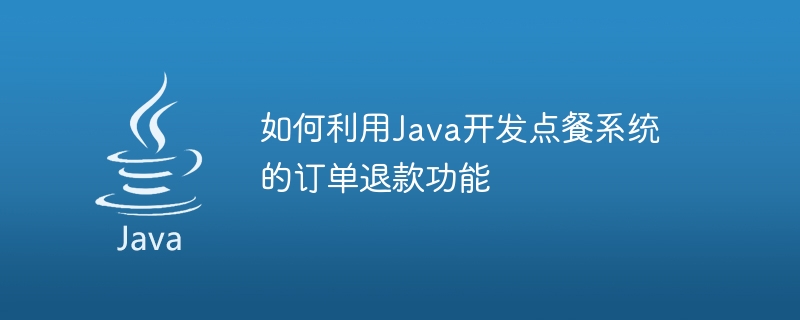

How to use Java to develop the order refund function of the ordering system
With the rapid development of the Internet, the ordering system has become the interaction between restaurants and consumers. important tool. In a complete ordering system, the order refund function is an integral part. This article will introduce how to use Java to develop the order refund function of the ordering system to improve user experience and management efficiency.
1. Requirements Analysis
Before developing the order refund function of the ordering system, the requirements must first be clarified. Generally speaking, the order refund function includes the following aspects:
1. Refund application: Users submit refund applications to the system based on actual needs. The application includes information such as order number, refund amount, reason for refund, etc.
2. Refund review: Refund applications need to be reviewed by the administrator. The administrator decides whether to agree to a refund based on information such as refund rules and order status.
3. Refund operation: If the refund application passes the review, the system needs to implement the refund operation. Refund operations include returning the money to the user's payment account or providing a refund method choice.
4. Refund record: The system needs to record the detailed information of the refund operation, including refund time, refund amount, refund method, etc.
2. System design
1. Database design: In order to implement the order refund function, corresponding tables need to be created in the database. The order form should contain order information, including order number, order amount, order status and other fields. The refund application form should contain refund application information, including order number, refund amount, refund reason and other fields. The refund record form should contain refund details, including refund time, refund amount, refund method and other fields.
2. Backend logic design: In the backend logic, the following modules need to be implemented:
3. Code Implementation
When implementing the order refund function of the ordering system, Java language and related technologies can be used to implement it. The specific steps are as follows:
1. Connect to the database: Use Java's database connection tool to connect to the database and obtain the database connection object.
2. Create database tables: Use SQL statements to create order forms, refund application forms and refund record forms in the database.
3. Implement the refund application module: According to the user's request, insert the refund application information into the refund application form and update the order status in the order form.
4. Implement the refund review module: the administrator reviews the refund application according to the corresponding rules, and updates the order status in the refund application form after passing the review.
5. Implement the refund operation module: According to the refund application information, return the money to the user's payment account or provide a refund method choice.
6. Implement the refund record module: insert the detailed information of the refund operation into the refund record form.
7. Close the database connection: Before the program ends, the database connection needs to be closed.
4. Testing
After completing the code implementation, testing is required to ensure that the order refund function can operate normally.
1. Simulate a user to apply for a refund: Use a test account to simulate a user to apply for a refund, and check whether the refund application information is normally stored in the database.
2. Simulate administrator review: Use the administrator account to conduct the review, and check whether the reviewed order status is updated correctly.
3. Simulate a refund operation: simulate a refund operation, return the money to the user's payment account or provide a refund method choice, and check whether the fields of the relevant forms are updated correctly.
4. Check the refund record: Check the refund record form to ensure that the details of the refund operation have been recorded.
5. Summary
Through the above steps, we can use Java to develop the order refund function of the ordering system. During the implementation process, steps such as requirements analysis, system design, code implementation and testing are required. Through the complete order refund function, the user experience and management efficiency can be improved, and better support can be provided for the interaction between restaurants and consumers.
The above is the detailed content of How to use Java to develop the order refund function of the ordering system. For more information, please follow other related articles on the PHP Chinese website!




